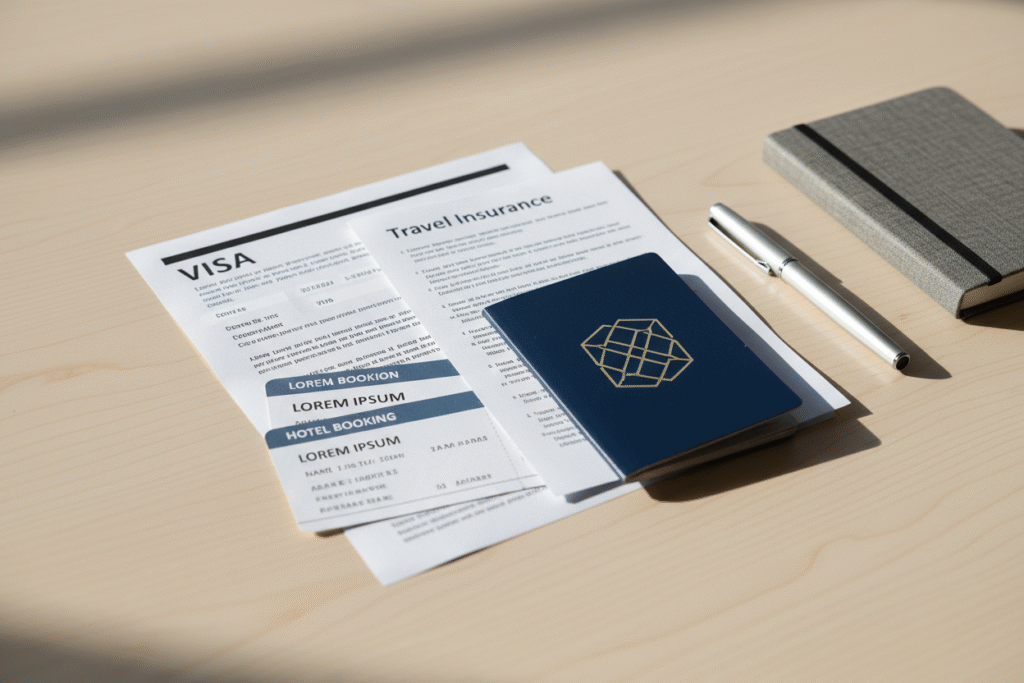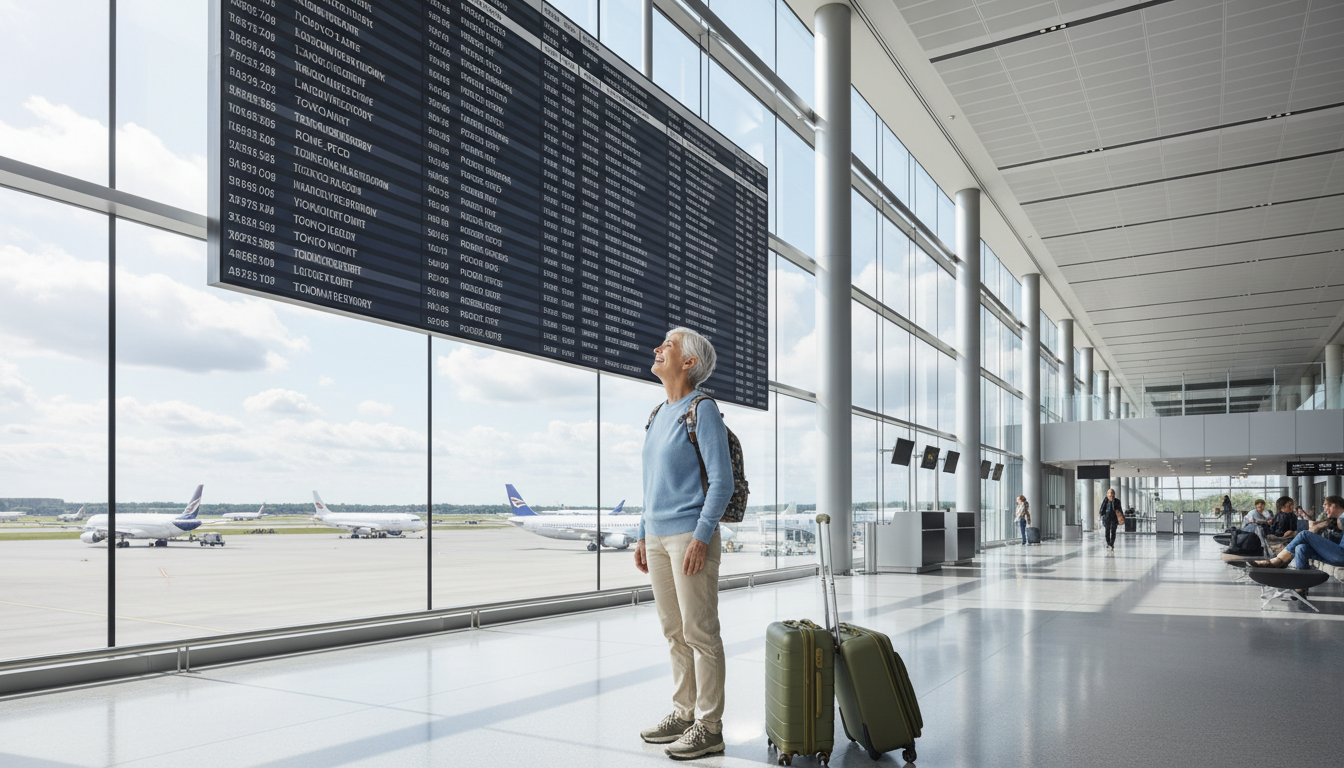First Time Traveling Overseas: Your Ultimate Guide for a Smooth and Fun Adventure
Planning your first time traveling overseas? This friendly, practical guide walks you through documents, packing, money, flights, safety, and jet lag—so your first international trip feels exciting, not overwhelming.
Planning your first international travel is a strangely specific emotional roller coaster. One minute you’re picturing yourself wandering down some charming cobblestone street with a coffee in hand, and the next you’re panicking because you’re not totally sure where your passport is… or if it’s even still valid.
I’ve been there. On my very first international travel, I was equal parts thrilled and mildly terrified. My suitcase was overstuffed, my carry on luggage was chaos, and I must’ve checked my email confirmations at least 20 times before I even got to the airport. I was convinced if I didn’t triple‑check everything, the plane might just leave without me.
The good news? You don’t have to learn it all the hard way like I did.
Whether you’re just starting to dream about your first overseas adventure or you’ve already booked your flight and now reality is setting in, this guide is meant to walk you through it step by step—with actually useful info, a few personal insights, and just enough humor to keep the stress levels down.
Let’s get you ready.
Why Your First International Trip Matters
There’s something special about your first time traveling abroad that you just don’t forget. It’s not only about where you go—it’s about what it does to you.
As international travelers, you’re stepping into new airports, new cultures, new languages, and quite possibly a new version of yourself. That probably sounds dramatic, but it’s surprisingly true. When you’re suddenly in a place where the signs don’t look familiar and the money doesn’t feel real yet, you’re forced to pay attention in a way you don’t at home. You stop running on autopilot and start really noticing things.
There’s real research behind this, too. A study in the Journal of Personality and Social Psychology found that people who spend time abroad tend to develop more flexible thinking and better problem-solving skills. In other words, your first time traveling overseas doesn’t just give you good photos—it quietly upgrades your brain.
Of course, it doesn’t always feel glamorous in the moment. Sometimes it feels like you vs. jet lag, or you vs. figuring out a foreign metro system while pretending you totally know what you’re doing. Sometimes it’s just you, a crumpled map, and a very confused expression. But that’s exactly why it matters. You prove to yourself, one small moment at a time, that you can handle more than you thought.
I still remember the first time I used a subway in another country on my own. Nothing dramatic happened—no missed trains, no panicked sprinting—just me, a ticket, a confusing color‑coded map, and a quiet hope that I’d picked the right line. When the train pulled into the exact stop I needed and I stepped out where I was supposed to be, I felt this small but powerful surge of pride. In that moment I thought, “Okay, I can actually do this,” and from then on, every trip felt a little easier because I’d proven to myself that I could figure things out, even when everything around me was unfamiliar.
Step 1: Get Your Travel Documents in Order
If your first time flying internationally were a movie, your passport would be the star of the show. Everything else is supporting cast.
Check Your Passport Like Your Trip Depends on It (Because It Does)
Before you even glance at flight deals, go find your passport. Not in your mind—physically. Hold it in your hand. Open it. Check the expiration date.
Many countries require your passport to be valid for at least six months beyond your planned return date. It’s a detail that’s easy to miss and incredibly painful to discover too late.
I once watched a guy at the check-in counter get turned away because his passport didn’t meet the six-month rule. The look on his face was a mix of disbelief and pure heartbreak. He had his bags, his ticket, probably a whole itinerary in his head—and then, “Sorry, you can’t board.” I didn’t even know him and I was stressed on his behalf. Learn from strangers at airports. Always check the date.
If you don’t have a passport yet, or it’s too close to expiry, apply as early as you can. Processing times can drag, and the last thing you want is to be refreshing a tracking page while your travel dates creep closer. Think of “get passport sorted” as the foundation everything else sits on.
I also like to:
- Take a clear photo of my passport info page
- Email it to myself
- Keep a printed copy in a different part of my bag
I hope I never need those backups, but I feel calmer knowing they’re there.

Don’t Forget About Visas
After passports comes the less glamorous, but very important, visa question.
Depending on your destination and your nationality, you might:
- Not need a visa at all
- Be able to get a visa on arrival
- Need to apply online ahead of time
- Have to mail in documents or visit a consulate
The rules vary wildly, so don’t guess. Check the official website of your destination country or your government’s travel advice page. When it’s your first time traveling internationally, a quick research session here saves you from a potentially trip-ending surprise later.
On one of my earlier trips, I almost missed a country’s requirement for an advance e‑visa that needed to be printed out. If I hadn’t double-checked, I would’ve shown up at the airport with a nice suitcase and no legal way to enter. Not exactly the vibe I was going for.
Make Copies of Important Documents
Yes, it’s boring. Yes, it matters.
Make digital and physical copies of:
- Your passport
- Visa (if required)
- Travel insurance
- Flight confirmations and accommodation details
Keep one set of copies in your carry on luggage and leave another with someone you trust at home. If something goes missing, having those copies can turn a disaster into an inconvenience.
I think of this step like flossing. It’s not exciting, but future-you will be grateful you did it.
Step 2: Research Your Destination Like a Pro
This is the part where your first time traveling internationally starts to feel exciting. You’re not just “going somewhere abroad” anymore—you’re getting to know an actual place.
Learn the Local Culture and Etiquette
Every country has its own rhythm, and a lot of small unspoken rules.
Some examples:
- In many European countries, you’re expected to greet shopkeepers when you enter
- In some cultures, modest dress is required in religious sites
- Certain gestures that are harmless at home might be rude elsewhere
Taking an hour to research basic etiquette can save you from unintentionally coming across as disrespectful.
When I visited a very conservative area on one of my trips, I was glad I’d read about local norms beforehand. It meant I could show respect instead of accidentally making people uncomfortable. It’s a small thing that makes a big difference, especially when it’s your trip to a foreign country and you’re still finding your footing.
Get Comfortable With Not Knowing the Language
If you’re going somewhere with a different language, don’t panic. You’re not expected to be fluent, but learning a handful of basic phrases makes you stand out—in a good way.
Practice:
- “Hello”
- “Please”
- “Thank you”
- “Excuse me”
- “Where is the bathroom?”
I’ve stumbled through a lot of badly pronounced phrases, and in almost every case, locals appreciated the effort. People are usually pretty kind when they see you’re trying.
Download a translation app before you go and, if possible, download the language for offline use. It’s incredibly useful when you’re staring at a menu or a sign and thinking, “I’m not entirely sure what I’d be ordering here.”
Between a few phrases, a translation app, and a sense of humor, you’ll be fine.
Know the “Don’ts” as Well as the “Dos”
While you’re researching fun things to do, take a moment to check for any common mistakes travelers make in that country.
Ask yourself:
- Are there laws about chewing gum, littering, or public drinking?
- Any rules about taking photos of government buildings or military areas?
- Are there places where certain clothing isn’t appropriate?
You don’t need to memorize a legal textbook—just enough to avoid the obvious pitfalls. Your first international travel is not the moment you want to learn a country has strict rules about something you take for granted at home.
Step 3: Planning Your Money Matters
Money isn’t the fun part of travel, especially for first timers, but it’s one of the most important—especially when everything is in a different currency and your brain is quietly doing math in the background.
Tell Your Bank You’re Leaving the Country
Before your first trip, notify your bank and credit card companies that you’ll be traveling. If you suddenly start swiping your card in another country without warning, your bank might assume fraud and block it.
I’ve had a card declined abroad because I forgot to do this. The transaction was totally normal; my bank just thought, “No way they’re in another country,” and shut it down. Nothing says “romantic dinner” like calling your bank at midnight from a restaurant.
Most banks now let you set a travel notice quickly through their app or website. It’s a small task that saves you big headaches.
Cards, Cash, and a Backup Plan
For your first time traveling overseas, a mix of cards and cash is usually best.
More tips you can use:
- Use cards for hotels, larger restaurants, and bigger purchases
- Keep some local cash for small shops, tips, local markets, and transit
- Don’t carry all your cash in one place
I always split my money and cards in at least two spots—one with me, one locked in my luggage or hotel safe. It’s basic risk management, but it’s also incredibly calming just knowing you have a backup.
And a quick note on exchanging money: airport exchange counters are convenient but often give worse rates. ATMs at reputable banks usually offer better value.
Step 4: Pack Smart and Light — Your Carry On Bag is Your Best Friend
Packing for your first time traveling overseas is where reality meets your Pinterest board. This is when you realize you can’t actually bring “a few options for every occasion” unless you’re okay with dragging half your home through multiple airports.

Think of Your Carry On as Your “Just in Case” Kit
Your carry on is more than a bag; it’s your safety net. If your checked luggage disappears for a day or two (or decides to visit another country without you), your carry on keeps you functioning.
In your carry on, include:
- Passport, visa, travel documents
- Wallet, cards, and some cash
- Medications and any essentials you wouldn’t want to replace
- Electronics (phone, chargers, maybe a power bank)
- A change of clothes
- Basic toiletries that follow the liquid rules
On one trip, my checked bag arrived 24 hours after I did. Mildly annoying, but not a crisis—because I had enough in my carry on to shower, change, and feel like a human while I waited.
Don’t Overpack “Just in Case”
This is where many first-time travelers (including past me) go off the rails. You start adding “just in case” items and suddenly your suitcase weighs more than you do.
A few realistic, simple tips:
- Stick to a simple color palette so you can mix and match
- Pack clothes you’re actually comfortable walking in for hours, not just ones that look good in photos
- Bring one “nicer” outfit if you know you’ll need it, not five
Packing cubes are amazing for organizing and making your bag feel less chaotic. I resisted them for a while, then finally tried them and immediately understood why people rave about them.
Make Space for the Unseen Essentials
The little, less glamorous items often end up being the heroes:
- A reusable water bottle
- Earplugs and an eye mask for flights or noisy hotels
- A small snack for when meals don’t go as planned
- A universal adapter if your destination uses different outlets
You probably won’t take a glamorous photo of your adapter, but you will absolutely be glad you have it when you’re trying to charge your phone at midnight.

Step 5: Book Early and Plan Ahead for International Flights
When it’s your first time traveling overseas, winging it on flights and accommodations is not as charming as it sounds. A little planning goes a very long way.
Give Yourself Breathing Room
Booking early usually means:
- Better prices
- More choice in flight times
- Better chances at decent layovers instead of rush-and-pray connections
If you have connecting flights, especially on different airlines, leave more time than you think you need. Big international airports can be confusing, and the last thing you want is to be that person sprinting through terminals, backpack bouncing, praying the gate is still open.
Secure a Place to Land
Once flights are booked, choose your accommodation—at least for the first few nights.
When you land in a new country for the first time, you’ll already be processing a lot: new signs, new time zone, new everything. Knowing exactly where you’re going to sleep that night is one less thing on your mental load.
After that, you can be as structured or flexible as your personality likes. Some people love a fully detailed itinerary, others prefer to decide on the go. For your first time traveling overseas, having at least a basic framework usually strikes a nice balance.
Step 6: Stay Safe and Healthy While Traveling Abroad
Safety doesn’t have to be a scary topic. Think of it as setting up guardrails so you can actually relax and enjoy yourself.
Stay Aware, Not Anxious
Some simple habits help a lot:
- Keep your bag zipped and in front of you in crowded places
- Don’t leave phones and wallets sitting on café tables in busy areas
- Be cautious if someone is being unusually pushy or insistent
Most people you meet will be kind and normal, but petty theft is more common in tourist areas. A little awareness keeps your first overseas trip memorable for good reasons, not because your wallet disappeared on day two.
Travel Insurance: The Safety Net You Don’t Want to Need
For international trips, travel insurance really is worth it. It can cover:
- Medical emergencies
- Lost or delayed luggage
- Trip cancellations or interruptions
I think of it like a helmet: you hope you never really “need” it, but if something goes wrong, you’ll be extremely glad you have it. Especially when you’re on your first time traveling overseas and still figuring out how things work in another country’s healthcare system.
Take Care of Your Health
Being in a new environment can throw off your routine. A few basics:
- Drink water regularly, especially on long flights
- Don’t push yourself to the point of exhaustion every day
- Check whether tap water is safe where you’re going
- Bring any medications you rely on—and a little extra, just in case of delays
Travel doesn’t have to be a non-stop sprint. It’s okay (and smart) to build in slower days.
Step 7: Manage Jet Lag Like a Travel Pro
Jet lag is basically your body asking, “Why are we eating dinner at what used to be 4 A.M.?”
It can hit hard on your first time traveling overseas, especially if you’re crossing many time zones. But you can soften the blow.
Before your trip:
- Try to adjust your bedtime slightly toward your destination’s time zone
- Don’t stay up all night packing (easier said than done, I know)
On the flight:
- Drink water instead of going wild on coffee or soda
- Move around occasionally so you don’t feel wrecked when you land
- If it’s nighttime at your destination, try to sleep at least a bit
When you arrive:
- Get outside into natural light—this helps reset your internal clock
- Try to eat and sleep on local time as soon as you can
- Avoid long naps, tempting as they are
I won’t pretend I’ve mastered jet lag, but I’ve definitely learned that forcing myself to stay awake until a reasonable local bedtime is worth it. That first night might feel like a blur, but day two and three are so much better.
Step 8: Stay Connected Without Breaking the Bank
On your first time traveling overseas, staying connected is both a comfort and a practical need. Good news: you have options besides “turn on roaming and pray.”
Choose How You’ll Stay Online
You can:
- Use an international plan from your carrier (convenient, sometimes pricey)
- Buy a local SIM card if your phone is unlocked (often the cheapest for data)
- Use a portable WiFi device, especially useful if you’re in a group
- Rely mostly on WiFi in hotels, cafés, and public spots
There’s no one perfect choice—it depends on your budget and how “always online” you want to be. Personally, I like having some data on my phone, even if it’s not unlimited. Knowing I can pull up a map or translation anywhere makes me feel way more relaxed.
Download Helpful Apps Before You Go
A couple of days before your trip, make sure you’ve downloaded:
- Offline maps for your destination
- A translation app
- A currency converter
- Your airline and accommodation apps
That way, you’re not trying to install big apps on slow airport WiFi when you’re already tired and just want to find your hotel.
Bonus Tips for First Time Travelers Abroad
A few quick extras that make a big difference:
- Check in online: It saves you time and sometimes lets you pick better seats before everyone else.
- Carry a crossbody bag: It’s practical, secure, and keeps your hands free. Once I switched, I never went back.
- Pack a reusable water bottle: Hydration plus fewer plastic bottles—it’s a win-win.
- Learn the local emergency number: It’s one of those things you hope you never need but should absolutely know.
- Build in “wandering time”: Some of the best parts of traveling happen when you’re not rushing anywhere specific.
Wrapping Up Your First Time Traveling Overseas
Your first time traveling overseas is a big deal—and you’re allowed to feel all the feelings about it. Excited, nervous, curious, unsure? All normal.
The key is preparation, not perfection. With your documents in order, your money sorted, your packing under control, and your expectations realistic, you’re already miles ahead of where I was on my first international trip.
You’ll make a few mistakes. Everyone does. You’ll probably have at least one moment where you think, “What am I doing?” But you’ll also have moments you’ll remember for years: a view that takes your breath away, a meal that ruins you for all future versions of that dish, a small kindness from a stranger when you needed it most.
Travel has a way of stretching you and grounding you at the same time. And that first overseas trip? It’s the start of all of it.
So, double-check that passport, finalize your plans, and give yourself permission to be both prepared and a little bit brave. Your first time traveling overseas doesn’t have to be perfect to be absolutely worth it.
Safe travels—and promise yourself this: you’re not just going to see a new place, you’re going to let it change you, just a little, in all the best ways.







